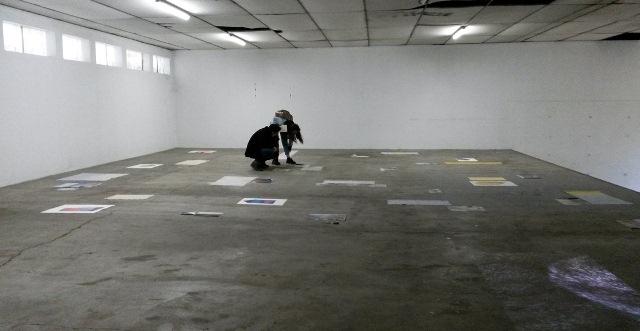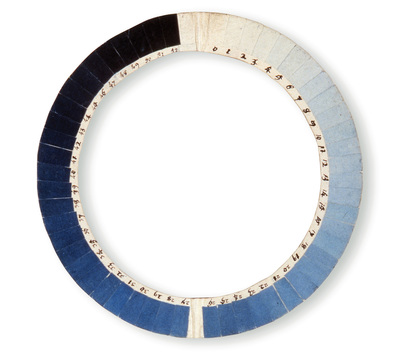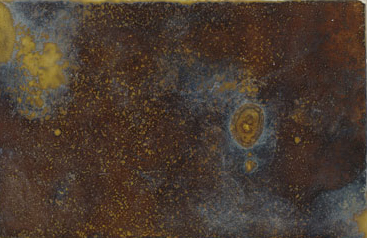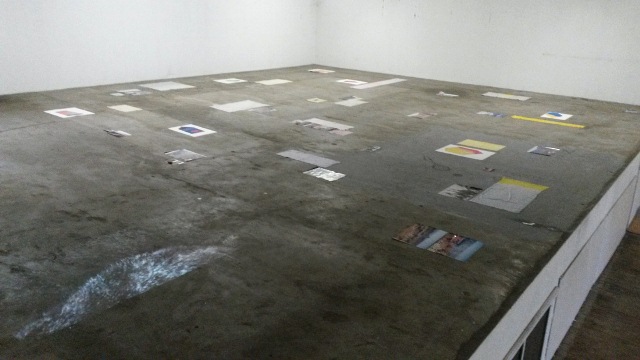Lauren Moya Ford
In Alfred Hitchcock’s Vertigo (1958), the two main characters go to California’s Muir Forest to see the sequoias. When they stop at a cross section of a tree trunk, the woman points to the rings and says, “Here I was born and here I died; it was only a moment for you, you took no notice.” The scene is unsettling because it shows that our own lives are not the only way to measure time. A sequoia’s lifespan can span hundreds or even thousands of years; as with cosmic and geologic time, the human spectrum is not at its center. Time can also be registered with different systems: in tree rings, rock layers, and crystal formations instead of hours or years. These natural elements appear in photographs along with dyed textiles, video, and gouache paintings in Cristina Regadas (Porto, 1977) installation Frame of Reference (campo contra-campo) at O Sol Aceita A Pele Para Ficar in Guimarães, Portugal.
Photographs, textiles, and paintings are arranged in evenly-spaced groupings set at right angles across the large cement floor of a former textile factory. No specific path is marked through the installation area; it is open to the visitor to decide how to navigate. This becomes a slow and thoughtful process because advancing in space presents new possibilities of visual association: this textile color field with that photographic landscape; this jewel-toned painting with that image of tropical palms. Winding around the floor elements organically, the visitor forms relationships to and between the materials as they return and reroute. Inside the installation with eyes trained on the ground, the installation fills our sight so that the thin paper and fabric objects on the floor appear to be floating in space. Our constant visual reordering of the groupings on the floor makes them seem even more mobile. We animate the materials through our movement, and through our thought.
Another thing that slows down the visitor’s step is the fact of looking down; it is the same pose that we take when hunting for a lost earring or for a particular type of wildflower. Looking is supposedly what we always do when we experience art, but Frame of Reference (campo contra-campo) requires a posture that is more about searching, as if we were foraging for something essential. To see these materials more closely, the visitor must lower their entire body to the floor. Bowing, then kneeling before the installation’s many photographs of canyons and deserts of the American Southwest felt reverent, appropriate, and somehow familiar. In my physical memory, this landscape compels me to genuflect: I kneel down to pick up a rock, to inspect a cactus bud, to check an animal’s stray footprint, or to spread a loved one’s ashes.

Cristina used to dance ballet, and her site-specific works demonstrate a special sensitivity to the choreography of the body. She dynamizes her photographic displays by requiring physical movement; for this reason, I write about visitors to the installation rather than viewers. Her previous large-scale installation, 18 de Outubro de 2014 at Porto’s Galeria Municipal Almeida Garrett, asked visitors to lean over low, table-like platforms as if they too were artists - investigators sifting through her collected materials. Frame of Reference (campo contra-campo) draws the body into walking, stooping, squatting, and kneeling over a wide, open floor. The range of motion has expanded and become more involved since her last installation, but the actions remain unhurried and intimate. Moving up, down, and around Frame of Reference (campo contra-campo) was a meditative repetition that bent my sense of time. When I finally emerged from the large installation space, it was difficult to say how long I’d been examining its contents.
Fabric strips and squares on the floor range from soft color fields to bright goldenrod. They were dyed with red cabbage, wild fennel, pomegranate, turmeric, beets, and hibiscus. The pigmentation process is a slow alchemy: fabric colors and intensities are determined by the materials they are soaked with, and for how long. Because none of the natural dyes were fixed to their surfaces with a mordant, their tones will change over time. This evolving color variation reminds me of Horace-Bénédict de Saussure’s cyanometer, with its 53 blue-tones used to measure the amount of water vapor in the sky. Another cyanometric parallel: each of Cristina’s textiles seem to absorb the building’s humidity (or other invisible forces) in their varying degrees of wrinkle or smoothness.
The textiles’ natural dyes and gentle colors made me imagine a panorama of aromatics even if the expansive industrial space didn’t preserve their original scents. One or two of the fabrics was graced by a dusty cat foot print (he lives in the space). I wonder: what sorts of residues are captured here? What other energies are playing on these surfaces? August Strindberg’s celestographs come to mind. In an effort to ‘capture’ a direct impression of the starry sky, the Swedish playwright left photographic plates outside or on his windowsill at night. The results of these experiments are wonderfully mixed: marks that Strindberg thought were imprints of stars were most likely made by dirt, dew, or some chemical glitch rather than light transmitted from the heavens. Yet something on the ground mimics something in the sky, and Cristina’s plant dyes recall a sunrise.


Horace-Bénédict de Saussure, cyanometer, 1789;
August Strindberg, celestograph, 1894
In his essay for the exhibition, José Almeida Pereira writes, “photographs in Cristina’s hands are reminiscent of cosmological journeys. They are transpositions of light that come from celestial explosions towards the present.” Light is the necessary ingredient in photography. Even though the photos in Frame of Reference (campo contra-campo) depict land-based phenomena, there is a sense of deep time, of a cosmological journey as José puts it. The passage of time within a larger universe is evidenced by up-close shots of rock and wood layers, massive geological formations like the Grand Canyon, found photos from the 1950s, a photo of Cristina as a little girl and one of her hand as an adult. In each case, the images preserve another moment when the sky and earth looked different than they do now, when different people were alive or dead. Assembled in Cristina’s installation, the photographs are in a continual journey towards the present.
Besides the two photos of the artist, Cristina’s hand appears in Campo (Field) (2016), the exhibition’s 8 mm film. In the film, she is holding a clear, crystal ball. Suddenly the film cuts and the ball becomes opaque, white, rubbery. In another moment, her hand reaches out to gingerly pinch a red cactus bud. We see the artist’s exploratory and transformative hand in the paintings, too. It is palpable in passages of brushwork left unsmoothed between rich areas of colors. Cut into angular forms on white backgrounds, the paintings vacillate between crystalline and map-like; maybe they are portals. Their’ hard, clean edges remind me of tended gardens in some of the installation’s photographs, while their brushy, bright interiors make me think of other photos’ natural, open spaces. In one of the groupings I recognized a photograph of cactus from the Porto Botanical Garden. It was sitting on top of a larger photograph of saguaro cactus growing wild in Arizona. I visited both sites at different points in my life, or in different rings of a sequoia tree, we could say. And so the layered photographs brought layered memories, throwing me into a sense of simultaneity from two very disparate places and times. Many of the photographs in Frame of Reference (campo contra-campo) depict the American West, a place made of promise and the unknown in equal parts. Even though Cristina spent an extended period traveling through the United States, these epic landscapes are all found photographs. It is appropriate: the promise remains a promise and the unknown remains unknown.
The shifts and plays on time at the center of Frame of Reference (campo contra-campo) create a moving, poetic experience. Maybe as a Texan, I’m an especially receptive visitor, because I saw things within the installation that triggered memories from other times, places, trips, and heart aches. Photographs of spiky alien desert plants in front of an electric blue sky brought me back to a hot afternoon many years ago when I was driving slowly through Joshua Tree National Park, searching for an oasis between the rock formations while the man I loved back then slept in the passenger seat. The radio was playing Gram Parsons, who had enjoyed this place so much that after he died his friends stole his coffin, took it to Joshua Tree, and set it on fire so that part of his body would remain there... or did I listen to Gram Parsons the next time I was at the park, still on a summer afternoon, but several years later?
Oh my land is like a wild goose
Wanders all around everywhere
Trembles and shakes till every tree is loose
It rolls the meadows and it rolls the nails
-Gram Parsons, A Song for You
_____
First publication of this text was at the blog Vigo Expo.
